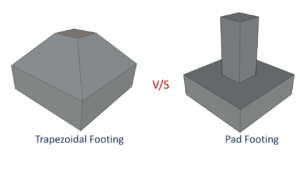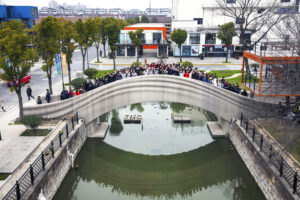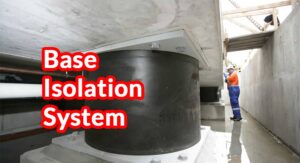
Top Civil Engineering Questions & Answers

Question 1. What are the major types of reinforcement used in prestressing?
Answer:
- Spalling reinforcement
- Equilibrium reinforcement
- Bursting Reinforcement
Question 2. How to determine the number of cells for concrete box girder bridges?
Answer:
If the depth of a concrete box girder bridge exceeds 1/6 or 1/5 of the total bridge width then the single-cell box girder bridge is recommended. But if the depth of the bridge is lower than 1/6 of the total bridge width then it is preferable to choose a twin-cell or in some cases multiple cells.
Question 3. What are the methods of concrete curing?
Answer:
- Shading concrete work
- Covering concrete surfaces with hessian or gunny bags
- Sprinkling of water
- Ponding method
- Membrane curing
- Steam curing
Question 4. Why are steel plates inserted inside bearings in elastomeric bearings?
Answer:
For elastomeric bearing to function as a soft spring, the bearing should be allowed for bulging laterally and the compression stiffness can be increased by limiting the amount of lateral bulging. To increase the compression stiffness of elastomeric bearings, metal plates are inserted.
After the addition of steel plates, the freedom to bulge is restricted and the deflection is reduced when compared with bearings without any steel plates under the same load. Tensile stresses are induced in these steel plates during their action in limiting the bulging of the elastomer. This, in turn, would limit the thickness of the steel plates.
Question 5. What is the Unit Weight of concrete?
Answer :
The unit weight of concrete depends on the type of aggregates and the amount of voids. As per IS: 456-2000, The Unit weight of plain concrete or PCC is 24KN/m3 and Reinforced concrete or RCC is 25KN/m3.
Question 6. What is the unit weight of Steel?
Answer :
The unit weight of Steel is given by 78.5KN/m3
Question 7. What’s the difference between a one-way slab and a two-way slab?
Answer :
One-way slab: Ratio of Longer Span to Shorter span is > 2 whereas; For two-way slab, the Ratio of Longer span to shorter span is <= 2
Question 8. What do you mean by One storeyed, Two storeyed building?
Answer :
The building which has two floors is called a two-storeyed building.
Question 9. What are the disadvantages of curing by ponding and polythene sheets?
Answer:
Disadvantages of Ponding Curing
The method is used for flat surfaces like pavements and floors.
- Ponding curing needs to be done under continuous supervision by professional labors.
- Cold wind affects ponding.
- After curing, a large amount of water needs to be disposed of the curing side.
Disadvantages of Polythene Sheets
The method is based on the theory that concrete will not be exposed in the air and no evaporation takes place. The followings are the reason why should you avoid curing by polythene sheets.
- Polythene sheets can be easily blown off.
- This does not work in windy weather.
- Polythene sheets may cause discoloration.
Question 10. What are the types of concrete slump?
Answer:
- True slump
- Shear slump
- Collapse slump
Question 11. What are the Nominal Concrete Mix proportions for various grades?
Answer :
Important: M20-1:1.5:3, M7.5- 1:4:8,
Less important: M5- 1:5:10 , M25- 1:1:2, M30-1:1:3 (Cement:Sand:aggregate)
Question 12. What is ductility?
Answer :
Ductility is Known as the ability to deform under tensile stress
Question 13. What are the types of a slump?
Answer :
- True Slump:After the test, the concrete is evenly spread and there is no disintegration in the shape of a slump.
- Shear Slump:Here one side of the slump slides down the other is known as shear slump, it is formed by a lean concrete mix.
- Collapse Slump:The slump fails or collapses due to excessive water, it is known as a collapse slump.
- Zero Slump: For very stiff and dry mixes, the sample doesn’t change it”s shape is known as zero slump.
Question 14. What are the concrete tests?
Answer :
Slump test, Compressive strength test, water permeability test, Water absorption test
Question 15. What is bleeding in concrete?
Answer :
Bleeding is one form of segregation, where water comes out to the surface of the concrete, being the lowest specific gravity among all the ingredients of concrete.
Question 16. What is the name of the machine to get the compression test?
Answer :
Universal testing machine (UTM)
Question 17. What is a flat slab?
Answer :
The slab which is supported on columns (Flab slab don’t have beams)
Question 18. What’s the height of each floor?
Answer : 3m
Question 19. What is the slope of Staircase?
Answer :
As per IS 456, the slope or pitch of stairs should be between 25 degrees to 40 degrees.
Question 20. What is a crank length in the slab?
Answer :
The crank length in Slab is 0.42 D. (Where D is Depth of Slab-Top cover-Bottom Cover)
Question 21. What do you mean by the moment of inertia?
Answer :
A quantity expressing a body’s tendency to resist angular acceleration, which is the sum of the products of the mass of each particle in the body with the square of its distance from the axis of rotation.
Question 22. What’s the length of rise and tread in the Staircase?
Answer :
Rise – 150mm to 200mm, Tread – 250mm to 300mm
Question 23. What is grouting?
Answer :
Grout is a fluid form of concrete, which is used to fill the voids.
Question 24. How do you check the quality of cement on the site?
Answer :
1. Date of Mfg: Cement strength decreases with its age.
2. Color: Colour should be grey with a light greenish shade and it should be uniform. Color gives an indication of excess lime or clay.
3. Float test: A good cement won’t float if you throw cement in water.
4. When you put your hand in the cement bag you should feel cool.
Question 25. What is Seepage?
Answer :
Slow percolation of water through soil is called Seepage.
Question 26. What is the Compressive Strength of brick?
Answer :
Second class brick-70kg/cm2
First class brick-105kg/cm2
Fire brick-125kg/cm2
Question 27. What is Initial & final setting time of concrete?
Answer :
Intial Setting time: 30mins, Final setting time: 10hrs
Question 28. What is the durability?
Answer :
Ability to withstand under pressure is called Durability.
Question 29. What is the allowable moisture content in Fine aggregate for the concrete mix?
Answer : We won’t use the aggregate if its moisture content is more than 5%
Question 30. What do you mean by segregation?
Answer :
Segragation is a separation of cement, sand from aggregate. This is caused due to Water cement ratio and when concrete is poured about more than 1.5m




